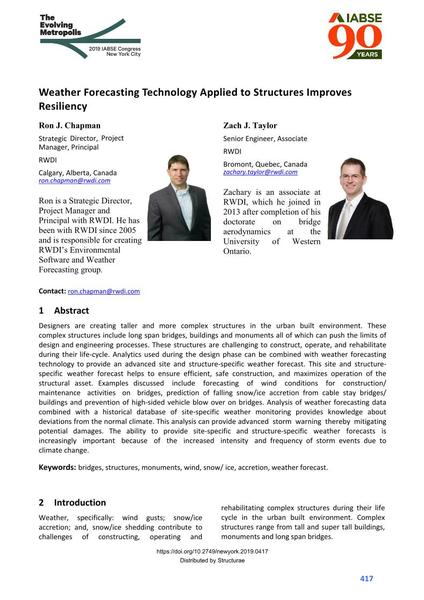Weather Forecasting Technology Applied to Structures Improves Resiliency

|
|
|||||||||||
Bibliographic Details
| Author(s): |
Ron J. Chapman
(RWDI)
Zach J. Taylor (RWDI) |
||||
|---|---|---|---|---|---|
| Medium: | conference paper | ||||
| Language(s): | English | ||||
| Conference: | IABSE Congress: The Evolving Metropolis, New York, NY, USA, 4-6 September 2019 | ||||
| Published in: | The Evolving Metropolis | ||||
|
|||||
| Page(s): | 417-423 | ||||
| Total no. of pages: | 7 | ||||
| DOI: | 10.2749/newyork.2019.0417 | ||||
| Abstract: |
Designers are creating taller and more complex structures in the urban built environment. These complex structures include long span bridges, buildings and monuments all of which can push the limits of design and engineering processes. These structures are challenging to construct, operate, and rehabilitate during their life-cycle. Analytics used during the design phase can be combined with weather forecasting technology to provide an advanced site and structure-specific weather forecast. This site and structure-specific weather forecast helps to ensure efficient, safe construction, and maximizes operation of the structural asset. Examples discussed include forecasting of wind conditions for construction/maintenance activities on bridges, prediction of falling snow/ice accretion from cable stay bridges/buildings and prevention of high-sided vehicle blow over on bridges. Analysis of weather forecasting data combined with a historical database of site-specific weather monitoring provides knowledge about deviations from the normal climate. This analysis can provide advanced storm warning thereby mitigating potential damages. The ability to provide site-specific and structure-specific weather forecasts is increasingly important because of the increased intensity and frequency of storm events due to climate change. |
||||
| Keywords: |
wind bridges structures monuments snow/ice accretion weather forecast
|
||||
